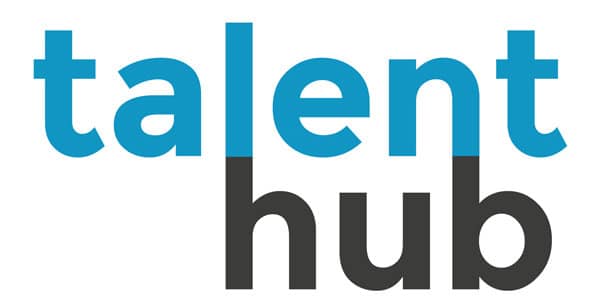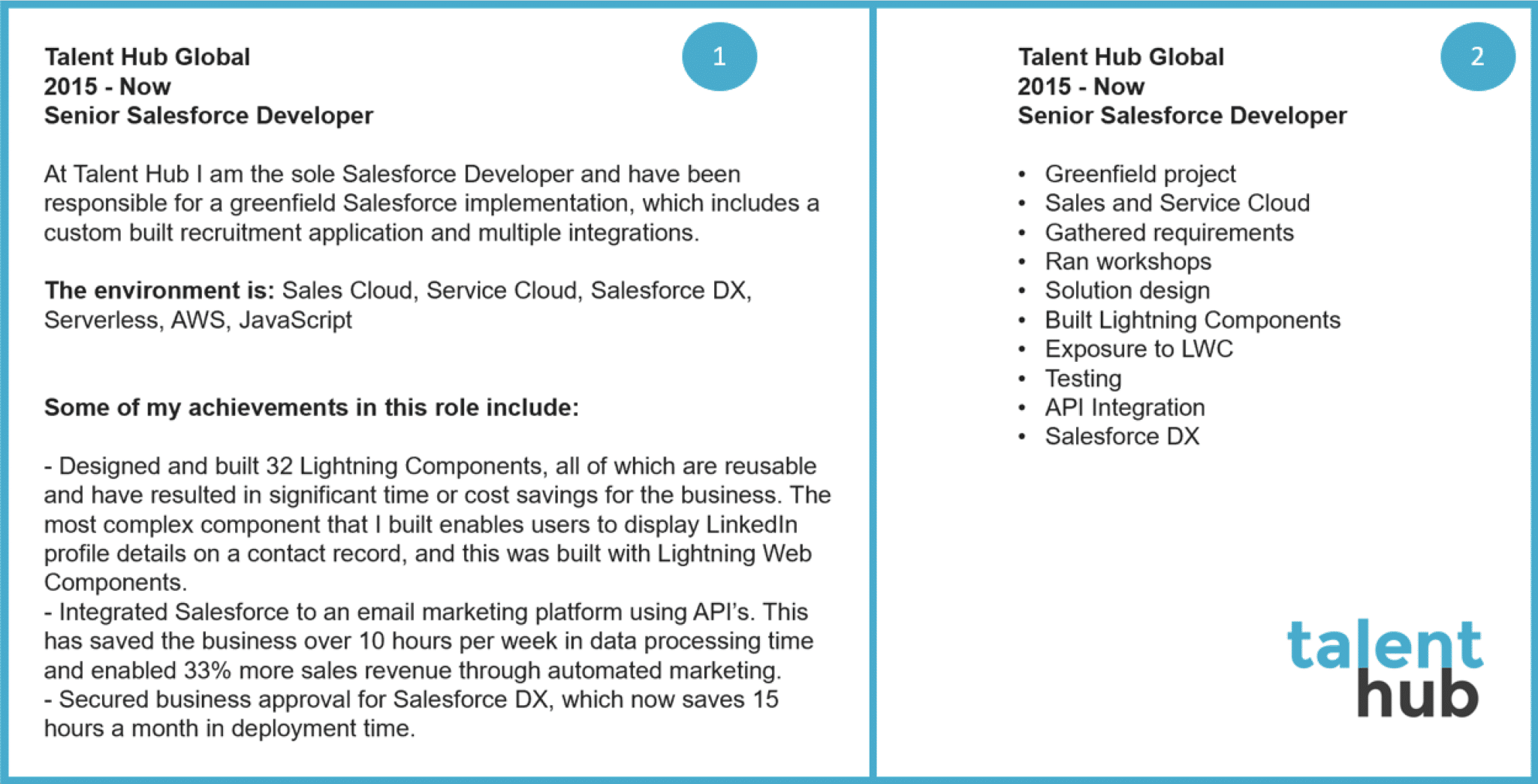How do you make your job ads stand out from the streams of other job ads which are aiming to attract the exact same pool of Salesforce candidates that you are?
If you can write an ad that your target candidate audience actually enjoys reading, and craft your copy to speak to their goals and aspirations, you’ll find them infinitely more effective.
“But”, we hear you say, “I have a list of requirements, a list of experience they need to have, certifications they need to hold. I need to make this clear in my ad.”
Okay. Do your job ads typically look like those on the left? And what would be the benefit of following a template like that on the right instead? We’ll explain.
Let’s re-imagine our job ad.
What is the role and who is it with?
Not
“Who we are”
Of course, the reader will need to know who the organisation is and the role title, but outside of the basic details here, they’re going to want to know what the role can do for them as their priority. The temptation is to sell the organisation in at this point in an attempt to impress, and write in a lot of detail, what makes your organisation the best. However, if you can keep it brief, it’ll avoid losing the reader with detail that just isn’t all that relevant to them just yet.
In our annual survey of Salesforce professionals of the ANZ market in 2020, only 7% of all those we asked, said that the company reputation was the most important factor when considering new opportunities. That’s a very small number of candidates who are going to appreciate your essay on accolades and turnover.
Why would it be a good place for me to work?
Not
“Why we need someone”
This is the main question the reader will be asking themselves when they clicked on your job ad. Answer this question for them in detail and your candidate can already begin to imagine being in a seat in your organisation. You could share how many users there are and the size of the team, for example. All of the details which give a flavour of the culture and whether the reader is going to be inspired and excited by, for example, your commitment to the platform.
You want them to like what they read enough here, to firstly, continue reading, and ultimately apply for the role.
They aren’t going to be nearly as interested in why you need someone, as you as the writer, are. If it’s a positive news story, such as the position has come about due to an internal promotion, you can mention it further down. But putting it early on in the piece, is just not going to be a powerful or effective hook.
What will I get to work on?
Not
“What you must have done previously”
This one is an important one for two reasons.
Firstly, what the reader will actually get to work on day-to-day and the responsibilities of the role are what the candidate really wants to know. This will tell them if yours is aligned with their preferences, given that any number of roles with the exact same job title can vary dramatically.
For example, they’ll want to know “which Clouds/products are used?”, “how much of the role is BAU work?”, “how much is project-based?”
Secondly, it’s been well documented that candidates take what you’ve put written on your job ads very seriously. Perhaps because they don’t understand the flexibility which exists within a recruitment process, or they overestimate the calibre of the other candidates who are applying.
According to a Hewlett Packard internal report based on the general population, nearly half of the respondents said that they wouldn’t apply unless they met close to, or even 100% of the criteria.
Interestingly, several studies cite that the main reason is not necessarily that they don’t believe that they can’t perform well in the role when they don’t meet all of the requirements, but because they think they won’t get the job in the first place. The predominant reason given was, “I didn’t think they would hire me since I didn’t meet the qualifications, and I didn’t want to waste my time and energy.”
And so you’re potentially pushing away a great number of fantastic candidates who, in your off paper opinion, would more than meet the true requirements of what you’re looking for, should you have ever been given the opportunity to connect with them.
As an example, Trineo include a well thought out line in their job ads, which we applaude:
Confidence can sometimes hold us back from applying for a job. But we’ll let you in on a secret: there’s no such thing as a ‘perfect’ candidate. Trineo is a place where everyone can grow. So however you identify, and whatever background you bring with you, please apply if this is a role that would make you excited to come into work every day.
What can I learn?
Not
“What it would be nice if you’d done before”
Candidates are looking to develop in their roles, learn new skills and deepen their experience. Whilst of course, you’d love them to have already done all of the things you need them to, there needs to be room for the person to grow in the role. And that means gaps. It means a lack of. If you’re looking for somebody who is already doing the exact same role, right now, somewhere else, what’s the incentive for them to move? And how long do you realistically believe they’d stay with you?
Inspiring the reader with all of the ways that they will be able to flourish in your role, is what will excite them. How they could advance further with your company than the one they currently work for?
In our annual survey of Salesforce professionals across ANZ in 2020, 30% said that the opportunity to work on interesting projects is the most important factor for them. It’s a high number year after year. Take note of this knowledge, and use it to your advantage.
What could the future growth look like for me and the role?
You can really excite your reader here by explaining how you see the role growing in the future, which gives a sense of purpose. They can see their future with you in their mind’s eye and have a glimpse of how their career could accelerate if they joined you. This would be a good place to mention if the role has become available due to internal promotion, to demonstrate a growth story.
Are there Developers in the organisation that have gone on to become CTA’s? Do you support additional learning, or perhaps you have a mentor program?
What else is on offer?
Not
“Who will hear from us”
This is your opportunity to go the extra mile and make that reader ‘click’ to apply, pick up the phone or send you a LinkedIn request. What’s on offer for them?
Perhaps you offer fantastic flexibility? 35% of our annual survey respondents highlighted this as the most important factor when considering new opportunities in 2020.
You might have industry-leading support for parents in the workplace, such a generous parental leave benefits, a Breastfeeding Friendly Workplace Accreditation, or employee wellness programs.
Don’t waste this opportunity to convert your job ad into an application from a person who might be your next star hire, with a negative final sentence such as ‘who will hear from us.’
End the piece with a compelling call to action, make it easy for them to apply, and we believe you’ll not only attract your target candidates, but that they’ll be more engaged throughout the process as a result of strong buy-in at this initial stage. You want them to think, “great, I got a call from the hiring manager”, not “hang on, I don’t remember applying for this role” when you call them for an interview.
So, have a look at how you can reposition your roles with your copywriting and job ads, and we’d love to hear your thoughts in the comments below!
Psst..did you know that we host a weekly Salesforce specific podcast? Head over to the Talent Hub Talk podcast page, for hours of valuable Salesforce and recruitment related content


